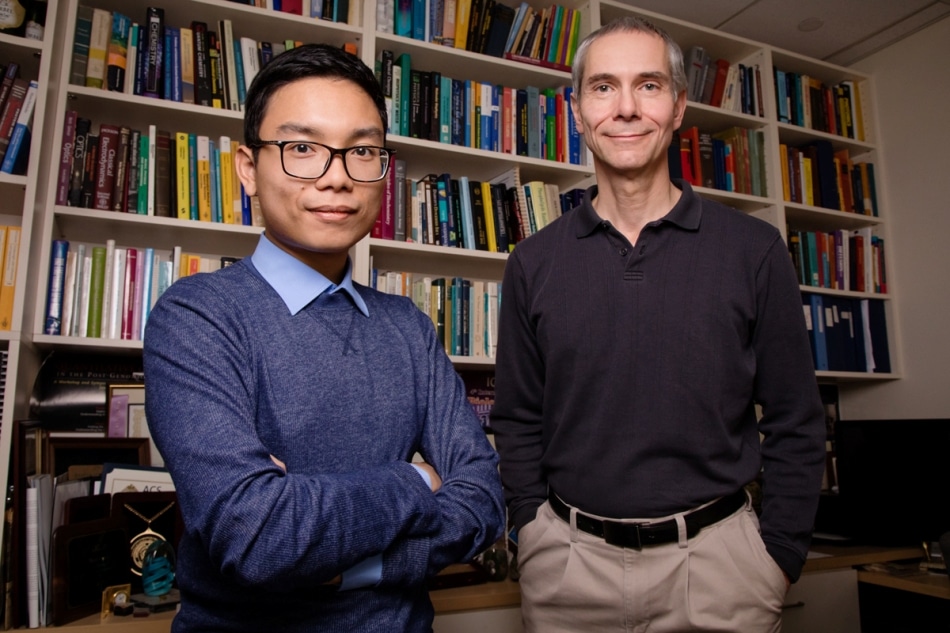Mar 1 2018
An imaging method that involves using a very sharp, tiny needle to nudge a single nanoparticle into distinctive orientations to take 2D images, to assist in reconstructing a 3D picture, has been devised by scientists. The technique exhibits imaging of individual nanoparticles at distinctive orientations when they are in a laser-induced excited state.
 Martin Gruebele, right, and graduate student Duc Nguyen led a team that is the first to demonstrate imaging of individual nanoparticles at different orientations while in a laser-induced excited state. Image credit: Photo by L. Brian Stauffer)
Martin Gruebele, right, and graduate student Duc Nguyen led a team that is the first to demonstrate imaging of individual nanoparticles at different orientations while in a laser-induced excited state. Image credit: Photo by L. Brian Stauffer)
The outcomes of the study have been reported in The Journal of Chemical Physics, and have drawn together scientists from the University of Illinois and the University of Washington, Seattle, in a partnership project through the Beckman Institute for Advanced Science and Technology at the University of Illinois.
Nanostructures such as carbon nanotubes, microchip semiconductors, and large protein molecules include flaws formed at the time of their synthesis. These flaws make them vary in composition from each other. Yet, these flaws are not necessarily a hindrance, stated Martin Gruebele, an Illinois chemistry professor and chair, who is the lead author of the study.
The term ‘defect’ is a bit of a misnomer. For example, semiconductors are manufactured with intentional defects that form the ‘holes’ that electrons jump into to produce electrical conductivity. Having the ability to image those defects could let us better characterize them and control their production.
Martin Gruebele
As developments in technology enable the synthesis of considerably smaller nanoparticles, it is important for engineers to have an insight into the accurate number and location of these flaws to ensure functionality and quality.
The research was concentrated on a category of nanoparticles termed quantum dots. These dots are very minute, almost-spherical semiconductors applied in technology such as live cell imaging, solar panels, and molecular electronics—the foundation of quantum computing.
The researchers detected the quantum dots using a single-molecule absorption scanning tunneling microscope that includes a needle sharpened to the tune that it has a thickness of just one atom at its tip. The needle pokes the individual particles on a surface and scans them to view the quantum dot from distinctive orientations to create a 3D image.
According to the team, there are two different benefits of the innovative SMA-STM technique as against the prevalent technique—the Nobel Prize-winning technique known as cryogenic electron tomography.
Instead of an image produced using an average of thousands of different particles, as is done with CryoET, SMA-STM can produce an image from a single particle in about 20 different orientations. And because we are not required to chill the particles to near-absolute zero temperatures, we can capture the particles at room temperature, not frozen and motionless.
Martin Gruebele
For this study, the scientists observed semiconductor quantum dots; however, SMA-STM can also be adopted to investigate other nanostructures such as metal nanoparticles, carbon nanotubes, or synthetic macromolecules. According to Gruebele, The team is confident that the method can be fine-tuned and used with soft materials such as protein molecules.
The team has been striving to develop SMA-STM into a single-particle tomography method, suggesting that they will have to demonstrate that the technique is noninvasive.
For SMA-STM to become a true single-particle tomography technique, we will need to prove that our nudges do not damage or score the nanoparticle in any way while rolled around. Knocking off just one atom can fundamentally alter the defect structure of the nanoparticle.
Martin Gruebele
This study was supported by the National Science Foundation, the Eiszner Family Foundation, and the Beckman Institute.
SMA-STM imaging of quantum dot
Video credit: University of Illinois